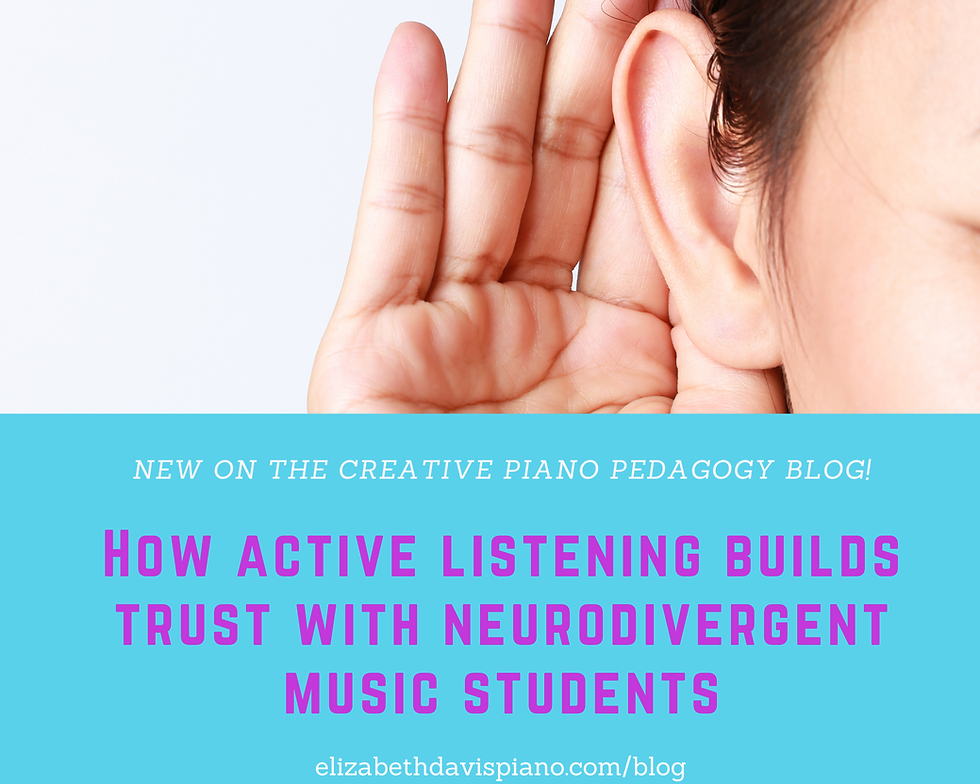Transform your Piano Teaching with a Bubble Timer
- Dr. Elizabeth

- Feb 12
- 4 min read

Today, I’m sharing about one of the most used (and most loved!) props in my teaching studio, how I use it and why my students love it- and likely, why yours will as well!
Disclaimer: I don’t often use hyperbole, especially for hyping up objects or items. So, when I say “this is the best purchase I’ve made in my studio,” I truly mean it. 👀
A bit of context: I’m an adult with ADHD and my studio has been beautifully neurodivergent for almost 20 years, so I’m always looking for ways to support my students’ musical growth as well as their non-musical skills such as socialization, self-regulation, working through moments of overwhelm, and so on. I also love using unique props and tools in my studio that help students find unexpected joy in learning.
Enter- the Bubble Timer!

I’ve used sand timers for years to help students with practicing at home and in lesson activities.
About 6-7 years ago while searching for a fidget toy on Amazon, I discovered the world of Bubble Timers and was instantly enamored. I immediately ordered a few and started using them in my studio to help students stay focused for theory activities and games, develop a sense of time, and for ‘brain breaks’ during the lesson. I quickly realized that this little timer would do so much more than just keep track of time, and started leaving it on the piano to see how students would interact with it on their own.
As a longtime teacher of students with autism and other diagnoses that often come with struggles in regulation, meltdowns and overwhelm, I’m always looking for new ways to learn what works best for my students and help them develop strategies for working through those difficulties.
One of my autistic students actually taught me the true value in this Bubble Timer, and it was a beautiful result of trust that was built over a lengthy period of time (at least one year).
Student H was experiencing some severe meltdowns and dysregulation in lessons, to the point that we often had to end lessons early or have the parents intervene. These behaviors were creeping in at school, church and other social situations and the parents were really struggling to manage and understand the behaviors.
One particularly difficult lesson, I pulled out the Bubble Timer and just quietly placed it on H’s piano, and turned it upside down so the colorful bubbles would gently begin to cascade. Student H grabbed the timer and held it close to his face, just watching the bubbles as they gently fell. He then said- “the bubbles are breathing as they fall, aren’t they.” And that was all he said, as we both sat and watched the bubbles.
After the bubbles finished falling, the students’ demeanor was visibly changed- the tension and stress was gone, he seemed more at peace and the meltdown dissipated, and we were able to transition to a new activity. 💡 moment!
–> Since that day about 7 years ago, I’ve been using the bubble timer for SO many things in my studio, and a big part of it is allowing the students to escape the mental/musical noise that’s creating overwhelm and just breathe with the bubbles.
I currently have a student with autism and he said this about the Bubble Timer last week: “My brain feels really noisy today, like I can’t take anymore information. The bubbles are really relaxing and calming- I can do deep breathing with them to help my brain not freak out so much.”
This might not sound like a very profound statement, but coming from a student with autism, apraxia, dyslexia, ADHD and other learning struggles, this was a beautifully articulated feeling and I was so grateful for the student verbalizing this for me.
[Side note: when I shared this conversation and interaction with the students’ dad, he had tears in his eyes. This skill of self-regulation, finding something to help the child divert from overwhelm and cope with it, has been a years-long process, and they immediately purchased a bunch of bubble timers for home and school. 💜 ]
--> I truly believe that our students are our greatest teachers, and we can learn so much from them- how they learn, think and see music, and the ways that work best for them. We just have to be open to observing, learning and making the adjustments needed.
How can you use the Bubble Timer?
There are so many ways to use it, but here are some of my/my students’ favorites!
timed games, activities, while listening/moving to music
brain breaks for when students need to improvise, move around, take a break from focused learning
regulation- when they’re overwhelmed/stressed, and for deep breathing to relax
timer for their least-favorite activity (playing chords, theory, repetitions of music, etc.)
timer for improvisation (play until the timer runs out)
challenge (“how many _____ can you circle in your music, how many minor chords can you play,” etc.) -talking/sharing time- when you have a talkative student who always has a lot to share, this is a great way to limit the time
Have you ever used a Bubble Timer, or are you excited to try it? I’d love to know how you’re excited to use it in your studio or what your students think of it! (If you want to check them out, here’s a link to the one I use on *Amazon. If you’re curious about other fidget toys and tools I use in my studio, you can see them here on my Amazon Storefront!)
Thanks for reading, and be sure to subscribe so you won’t miss upcoming blog posts!
Until next time,
Elizabeth
*As an Amazon Affiliate, I may receive a small commission if you purchase through this link- at no extra cost to you.



Comments